Follow 2000 years of history along the Kibworth and Smeeton Westerby Trail.
You can download a map and follow the Kibworth and Smeeton Westerby trail by visiting the www.kibworthvillage.co.uk/trails.htm website.
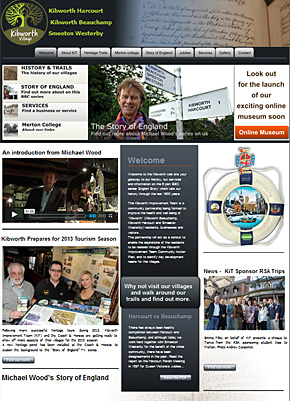
You can download a map and follow the Kibworth and Smeeton Westerby trail by visiting the www.kibworthvillage.co.uk/trails.htm website.
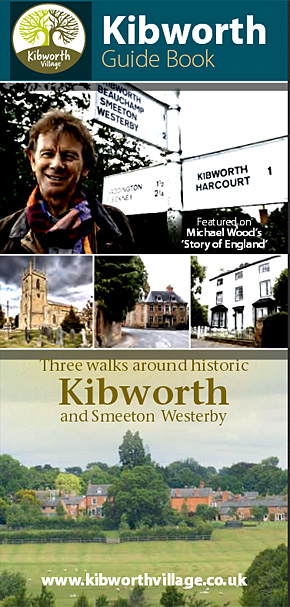
The purpose of the Smeeton Westerby website is to promote the services, activities and events happening in the village.
The Historic Village of Smeeton Westerby Smeeton Westerby, approximately 10 miles south east of Leicester, was originally two separate villages. Smeeton and Westerby. Smeeton; ‘Smitone; or ‘Smithstun’, old English names, had existed since well before the ninth century. Westerby, once known by its Old Norse name of Vesterbyr, the ‘West Farm’, was founded by Viking settlers after the Viking Army disbanded in 877. The boundary believed to marked by two white stones next to Westerby House.
Westerby House is faces the southern end of the main street and is an eighteenth century building constructed of brick.
The main source of income was farming, however in the nineteenth century framework knitting also provided local employment.
As it is a conservation village there has been little change to the size of the village apart from the small developments on the former factory site and Mill Lane.
In 1975 an ancient burial site of the Beaker people was discovered just outside the village.
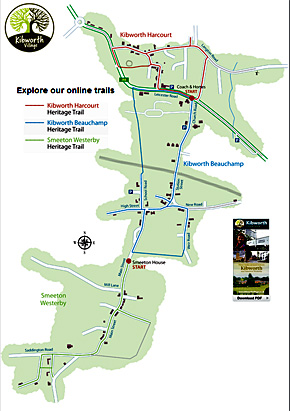
Michael Woods Story of England DVD
or
Michael Woods Story of England book
If you wish to book the Smeeton Westerby Village Hall please contact
Chris Gibbins - Tel. 07808 469916
For all other enquiries concerning the Village Hall please contact
Nicola Hopkinson Tel. 0116 2796779
Further information about the Village Hall will appear here in the near future.
Smeeton Westerby Village Trail
The can download a map and follow the Kibworth and Smeeton Westerby trail by visiting the www.kibworthvillage.co.uk/trails.htm website.
Thank you to Phillip J. Porter, author of "Kibworth to Smeeton Westerby" book, the Kibworth Improvement Team, Michael Woods and The National Lottery and for their time and support in producing this guide.
Michael Woods Story of England DVD or Michael Woods Story of England book
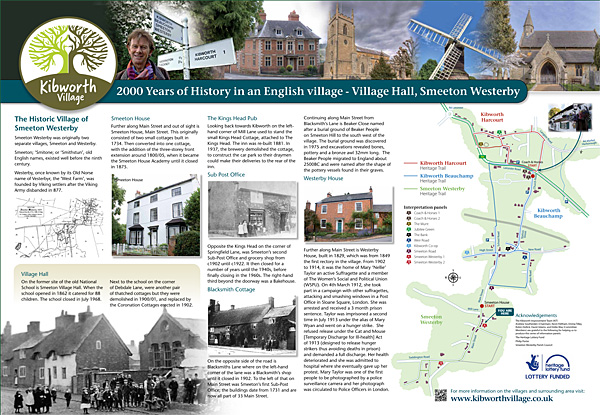
The Historic Village of Smeeton Westerby
Smeeton Westerby was originally two separate villages, Smeeton and Westerby. Smeeton; ‘Smitone; or ‘Smithstun’, old English names, existed well before the ninth century. Westerby, once known by its Old Norse name of Vesterbyr, the ‘West Farm’, was founded by Viking settlers after the Viking Army disbanded in 877.
Village Hall
On the former site of the old National School is Smeeton Village Hall. When the school opened in 1862 it catered for 88 children. The school closed in July 1968. Next to the school on the corner of Debdale Lane, were another pair of thatched cottages but they were demolished in 1900/01, and replaced by the Coronation Cottages erected in 1902.
Smeeton House
Further along Main Street and out of sight is Smeeton House, Main Street. This originally consisted of two small cottages built in 1734. Then converted into one cottage, with the addition of the three-storey front extension around 1800/05, when it became the Smeeton House Academy until it closed in 1875.
The Kings Head Pub
Looking back towards Kibworth on the lefthand corner of Mill Lane used to stand the small Kings Head Cottage, attached to The Kings Head. The inn was re-built 1881. In 1937, the brewery demolished the cottage, to construct the car park so their draymen could make their deliveries to the rear of the inn.
Sub Post Office
Opposite the Kings Head on the corner of Springfield Lane, was Smeeton’s second Sub-Post Office and grocery shop from c1902 until c1922. It then closed for a number of years until the 1940s, before finally closing in the 1960s. The right-hand third beyond the doorway was a Bakehouse.
Blacksmith Cottage
On the opposite side of the road is Blacksmiths Lane where on the left-hand corner of the lane was a Blacksmith’s shop until it closed in 1902. To the left of that on Main Street was Smeeton’s first Sub-Post Office; the buildings date from 1731 and are now all part of 33 Main Street. Continuing along Main Street from Blacksmith’s Lane is Beaker Close named after a burial ground of Beaker People on Smeeton Hill to the south west of the village. The burial ground was discovered in 1975 and excavations revealed bones, pottery and a bronze awl 32mm long. The Beaker People migrated to England about 2500BC and were named after the shape of the pottery vessels found in their graves.
Westerby House
Further along Main Street is Westerby House, built in 1829, which was from 1849 the first rectory in the village. From 1902 to 1914, it was the home of Mary ‘Nellie’ Taylor an active Suffragette and a member of The Women’s Social and Political Union (WSPU). On 4th March 1912, she took part in a campaign with other suffragettes, attacking and smashing windows in a Post Office in Sloane Square, London. She was arrested and received a 3 month prison sentence. Taylor was imprisoned a second time in July 1913 under the alias of Mary Wyan and went on a hunger strike. She refused release under the Cat and Mouse [Temporary Discharge for Ill-health] Act of 1913 (designed to release hunger strikers thus avoiding deaths in prison) and demanded a full discharge. Her health deteriorated and she was admitted to hospital where she eventually gave up her protest. Mary Taylor was one of the first people to be photographed by a police surveillance camera and her photograph was circulated to Police Officers in London.
The can download a map and follow the Kibworth and Smeeton Westerby trail by visiting the www.kibworthvillage.co.uk/trails.htm website.
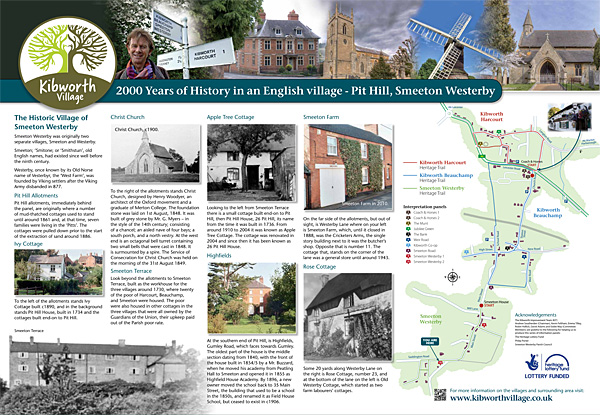
Pit Hill Allotments
Pit Hill Allotments Pit Hill allotments, immediately behind the panel, are originally where a number of mud-thatched cottages used to stand until around 1861 and, at that time, seven families were living in the ‘Pitts’. The cottages were pulled down prior to the start of the extraction of sand around 1886.
Ivy Cottage
To the left of the allotments stands Ivy Cottage built c1890, and in the background stands Pit Hill House, built in 1734 and the cottages built end-on to Pit Hill.
Christ Church
To the right of the allotments stands Christ Church, designed by Henry Woodyer, an architect of the Oxford movement and a graduate of Merton College. The foundation stone was laid on 1st August, 1848. It was built of grey stone by Mr. G. Myers – in the style of the 14th century; consisting of a chancel; an aisled nave of four bays; a south porch, and a north vestry. At the west end is an octagonal bell turret containing two small bells that were cast in 1848. It is surmounted by a spire. The Service of Consecration for Christ Church was held on the morning of the 31st August 1849.
Smeeton Terrace
Look beyond the allotments to Smeeton Terrace, built as the workhouse for the three villages around 1730, where twenty of the poor of Harcourt, Beauchamp, and Smeeton were housed. The poor were also housed in other cottages in the three villages that were all owned by the Guardians of the Union, their upkeep paid out of the Parish poor rate.
Apple Tree Cottage
Looking to the left from Smeeton Terrace there is a small cottage built end-on to Pit Hill, then Pit Hill House, 26 Pit Hill, its name from the time it was built in 1736. From around 1910 to 2004 it was known as Apple Tree Cottage. The cottage was renovated in 2004 and since then it has been known as 26 Pit Hill House.
Highfields
At the southern end of Pit Hill, is Highfields, Gumley Road, which faces towards Gumley. The oldest part of the house is the middle section dating from 1840, with the front of the house built in 1854/5 by a Mr. Buzzard, when he moved his academy from Peatling Hall to Smeeton and opened it in 1855 as Highfield House Academy. By 1896, a new owner moved the school back to 35 Main Street, the building that used to be a school in the 1850s, and renamed it as Field House School, but ceased to exist in c1906.
On the far side of the allotments, but out of sight, is Westerby Lane where on your left is Smeeton Farm, which, until it closed in 1888, was the Cricketers Arms, the single story building next to it was the butcher’s shop. Opposite that is number 11. The cottage that, stands on the corner of the lane was a general store until around 1943.
Rose Cottage
Some 20 yards along Westerby Lane on the right is Rose Cottage, number 23, and at the bottom of the lane on the left is Old Westerby Cottage, which started as two farm labourers’ cottages.
The can download a map and follow the Kibworth and Smeeton Westerby trail by visiting the www.kibworthvillage.co.uk/trails.htm website.